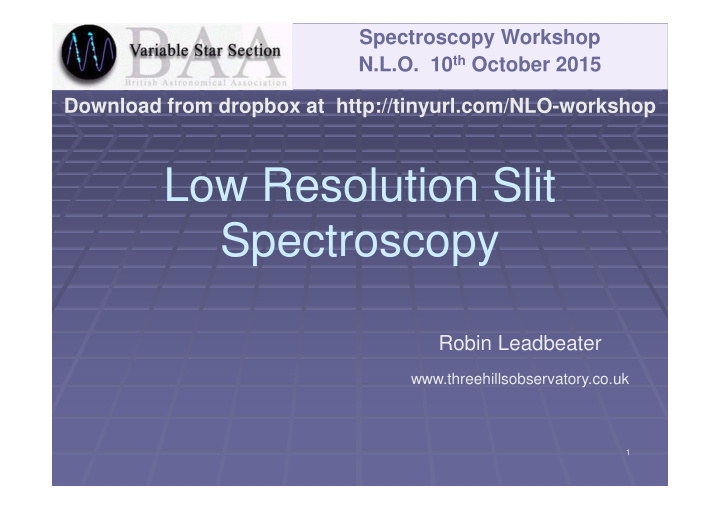



Spectroscopy Workshop N.L.O. 10 th October 2015 Download from dropbox at http://tinyurl.com/NLO-workshop Low Resolution Slit Spectroscopy Robin Leadbeater www.threehillsobservatory.co.uk 1
The slit spectrograph Advantages Collimating the beam at the grating eliminates aberrations at higher dispersion, allowing potentially much higher resolutions Fixed sampled width of target means extended objects can be measured and the resolution is constant and controlled Excludes sky background improving SNR and eliminating interference Provides a fixed reference point for wavelength calibration Diffuse lamps can be used as calibration sources Flat correction simpler (flats will also remove small scale instrument sensitivity variations) 2
The slit spectrograph Disadvantages Increased cost and complexity over a simple non-objective slitless grating setup Need to acquire, focus and guide the star on the slit (key to success and not trivial) Proportion of light through slit not controlled, preventing absolute flux measurement 3
Transmission grating slit spectrograph Open University TRAGOS (Vadim Burwitz 2004) Mirror slit guider Collimator lens Grism Camera lens 4
ALPY 600 at Three Hills Observatory Celestron C11 .63 focal reducer Guider camera Calibration module Guider module ALPY core module Imaging camera 5
Measuring the spectra of MILES stars of various spectral types using an ALPY 600 2013-08-02 The Targets and observation details star spec type Vmag time az alt air mass exposure HD214994 A1v 4.8 22:05 93 40 1.6 20x10s HD217014 G5v 5.4 22:20 100 34 1.8 10x10s HD218031 K0iii 4.6 22:39 72 55 1.2 13x10s refocused HD218031 K0iii 4.6 22:43 73 55 1.2 10x10s HD183324 A0v 5.8 22:56 179 38 1.6 20x 5s (Intermittent thin cloud) 6
raw reference star spectrum HD214994 A0v 7
Neon / Argon lamp spectrum 8
Tungsten Halogen lamp flat 9
Prepare master flat and offset images 10
Wavelength calibration options For this example use predefined mode 11
Correct spectrum tilt and select binning and sky background zones 12
Correct for smile/slant of lines and enter location of reference line 13
Run the spectrum processing from raw images to wavelength calibrated profile 14
The wavelength calibrated profile 15
Calculate raw instrument response MILES Measured Raw response 16
Final instrument response curve Save it! 17
Re-run processing including instrument response correction 18
The final result calibrated in wavelength and relative flux 19
ISIS enters information about the observation in the FITS header 20
HD214994 A1v Measured MILES 21
HD217014 G5v Measured MILES Note slight error in continuum (high air mass 1.8 v 1.6 for ref star ?) 22
HD218031 K0iii Measured MILES Small error in continuum (low air mass 1.2 v 1.6 ?) 23
HD218031 K0iii Refocused Measured MILES Note the significant change in continuum shape with focus change 24
HD183324 A0v Measured MILES The error due to refocusing is clearly seen here too 25
HD183324 used to generate a new response Measured MILES 26
Refocused HD218031 spectrum corrected using new response Measured MILES The continuum correction is now good 27
Using a modified ALPY spectrograph for Supernova identification Potential Supernovae, once discovered need spectroscopic follow up for confirmation and identification of type With the increased use of automated surveys to detect transients, the emphasis for the amateur is shifting from discovery to follow up. Except for a few bright examples, Supernova spectroscopy has proved tough for the typical amateur. (To be useful, magnitudes fainter than mag 16 need to be reached) Low resolution R~100 is sufficient to confirm and produce a preliminary classification so within range of the Star Analyser but getting results below ~mag 15 has proved difficult A potential alternative approach is to use a slit spectrograph designed for the minimum resolution required An ALPY 600 spectrograph was therefore modified to reduce its resolution to ~130 28
MODIFYING THE ALPY SPECTROGRAPH (ALPY 200) Removing the the Grism from the ALPY Core Module Taking care that the collimator lens does not fall out! Standard Modified 600 l/mm 200 l/mm Grism Grism (Made using the Star Analyser 200 master grating) 29
BENCH TESTS - ALPY 200 v 600 Resolution Efficiency The dispersion and resolution of the The efficiency of the 200 l/mm grism is ALPY200 are ~ 4 lower ~ 2x that of the 600 l/mm grism compared with the ALPY 600 Combining this with the 4x reduction R = 130 at 6000 A is sufficient for in dispersion results in an supernova identification for example 8x brighter spectrum 30
ADVANTAGES OF THE ALPY 200 Compared with the Star Analyser The slit reduces the sky background level by a factor of ~100, reducing sky noise and eliminating interference from field stars and their spectra. The mirror slit guider allows longer individual exposures, reducing the total camera read noise contribution. The fully collimated optics produce a sharp spectrum over the full wavelength range, allowing a lower dispersion to be used for the same resolution. Compared with the ALPY 600 The higher efficiency of the 200 l/mm grism increases the flux in the spectrum. The reduced dispersion minimises the camera thermal noise contribution compared with increasing the effective pixel size by in camera binning 31
PSNJ15024996+4847062_20140521 in PGC 2325560 (mag ~16) discovered amateurs R. Gagliano, J. Newton T. Puckett 2014-05-13 guide star Spectrum image before and after sky subtraction Discovery image Spectrum of the supernova (centre). The lower spectrum is a field star caught in the slit Reduced spectrum (red) 2014-05-21 60 min exposure overlaid on professional spectrum (blue) taken 6 days earlier (ATel 6140) The spectrum shows a strong Si II 6150 absorption feature GELATO redshifted to 6300 A supernova identification program (characteristic of type Ia) gives an excellent fit to type Ia 32 a few days after maximum
ASASSN 15fa in NGC 6319 29 days after discovery at mag ~17.5 ASASSN 15fa was discovered by the All Sky Automated Survey for Supernovae on 2015-03-17 (ATel 7245) and identified from a spectrum taken by the Asiago Transient Classification Program as a type 1a supernova (ATel 7253). guider image (15x 20s) ALPY 200 spectrum (black) compared With best fit GELATO spectrum at 30 days raw spectrum (bright star below is mag 11) 33
Recommend
More recommend